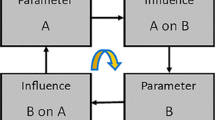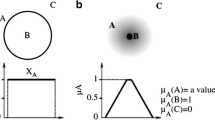Abstract
In the civil and mining projects, blasting operation is important from technical and economical point of view. There are several parameters which affect the result of operation such as desired fragmentation and undesired phenomena, e.g., ground vibration, fly rock, etc. From these parameters, rock mass characterizations can be considered as more influential as compared to the blasting pattern. In other words, it can be said that pattern specifications should primarily be designed according to the rock mass properties to reach the main objective of the operation, i.e., rock fragmentation. Complex nature of the problem needs to implement robust approaches such as artificial intelligence-based techniques. In this paper, an attempt has been made to develop some models by which the impact of each and every parameter influencing the result of blasting operation can be evaluated. For this research work, 432 datasets from 14 mines situated in the different parts of the world has been collected. In developing of the models, 19 parameters such as uniaxial compressive strength, tensile strength, brittleness, Point Load Index, Young’s modulus, Poisson’s ratio, rock quality designation, cohesion, friction angle, burden, spacing and stemming were incorporated. Regression analysis, decision tree and artificial neural network methods were employed for developing the models for predicting fragmentation. Determination coefficient (R2) for artificial neural network modeling, multivariate linear regression and decision tree was computed 0.98, 0.83 and 0.45, respectively, showing accuracy of network modeling over the other applied methods. In addition, it was revealed that the most influential parameters on fragmentation are Point Load Index, uniaxial compressive strength, Poisson’s ratio, cohesion and rock quality designation, respectively, and the least effective ones are stemming, spacing and hole diameter, respectively.












Similar content being viewed by others
References
Armaghani DJ, Hajihassani M, Mohamad ET, Marto A, Noorani S (2014) Blasting-induced flyrock and ground vibration prediction through an expert artificial neural network based on particle swarm optimization. Arabian J Geosci 7(12):5383–5396
Khandelwal M, Monjezi M (2013) Prediction of backbreak in open-pit blasting operations using the machine learning method. Rock Mech Rock Eng 46(2):389–396
Monjezi M, Khoshalan HA, Varjani AY (2012) Prediction of flyrock and backbreak in open pit blasting operation: a neuro-genetic approach. Arab J Geosci 5(3):441–448
Görgülü K, Arpaz E, Demirci A, Koçaslan A, Dilmaç MK, Yüksek AG (2013) Investigation of blast-induced ground vibrations in the Tülü boron open pit mine. Bull Eng Geol Environ 72(3–4):555–564
Hajihassani M, Armaghani DJ, Marto A, Mohamad ET (2015) Ground vibration prediction in quarry blasting through an artificial neural network optimized by imperialist competitive algorithm. Bull Eng Geol Environ 74(3):873–886
Raina A, Murthy V, Soni A (2014) Flyrock in bench blasting: a comprehensive review. Bull Eng Geol Environ 73(4):1199–1209
Michaux S, Djordjevic N (2005) Influence of explosive energy on the strength of the rock fragments and SAG mill throughput. Miner Eng 18(4):439–448
Monjezi M, Rezaei M, Varjani AY (2009) Prediction of rock fragmentation due to blasting in Gol-E-Gohar iron mine using fuzzy logic. Int J Rock Mech Min Sci 46(8):1273–1280
Thornton D, Kanchibotla S, Brunton I (2002) Modelling the impact of rockmass and blast design variation on blast fragmentation. Fragblast 6(2):169–188
Zhu Z, Mohanty B, Xie H (2007) Numerical investigation of blasting-induced crack initiation and propagation in rocks. Int J Rock Mech Min Sci 44(3):412–424
Atici U (2011) Prediction of the strength of mineral admixture concrete using multivariable regression analysis and an artificial neural network. Expert Syst Appl 38(8):9609–9618
Mohamad ET, Hajihassani M, Armaghani DJ, Marto A (2012) Simulation of blasting-induced air overpressure by means of artificial neural networks. Int Rev Modell Simul 5:2501–2506
Mohamad ET, Armaghani DJ, Momeni E, Abad SVANK (2015) Prediction of the unconfined compressive strength of soft rocks: a PSO-based ANN approach. Bull Eng Geol Environ 74(3):745–757
Armaghani DJ, Hajihassani M, Bejarbaneh BY, Marto A, Mohamad ET (2014) Indirect measure of shale shear strength parameters by means of rock index tests through an optimized artificial neural network. Measurement 55:487–498
Asl PF, Monjezi M, Hamidi JK, Armaghani DJ (2017) Optimization of flyrock and rock fragmentation in the Tajareh limestone mine using metaheuristics method of firefly algorithm. Eng Computers:1–11
Trippi RR, Turban E (1992) Neural networks in finance and investing: using artificial intelligence to improve real world performance. McGraw-Hill, Inc., New York
Abbassi A, Bahar L (2005) Application of neural network for the modeling and control of evaporative condenser cooling load. Appl Therm Eng 25(17):3176–3186
Kosko B (1992) Neural networks and fuzzy systems: a dynamical systems approach to machine intelligence/book and disk, vol 1. Prentice hall, Upper Saddle River
Peisheng L, Youhui X, Dunxi Y, Xuexin S (2005) Prediction of grindability with multivariable regression and neural network in Chinese coal. Fuel 84(18):2384–2388
Simpson PK (1990) Artificial neural systems: foundations, paradigms, applications, and implementations. Pergamon 1:34–36
Tambe SS, Deshpande PB, Kulkarni BD, Ramani S (1996) Elements of artificial neural networks with selected applications in chemical engineering, and chemical & biological sciences. Simul Adv Controls Inc 1:56–61
Wasserman PD (1989) Neural computing. Van Nostrand Reinhold, New York
Anderson JA (1995) An introduction to neural networks. MIT press, Cambridge
Chauvin Y, Rumelhart DE (1995) Backpropagation: theory, architectures, and applications. Lawrence Erlbaum Associates, Hillsdale, NJ
Neaupane KM, Achet SH (2004) Use of backpropagation neural network for landslide monitoring: a case study in the higher Himalaya. Eng Geol 74(3):213–226
Monjezi M, Mehrdanesh A, Malek A, Khandelwal M (2013) Evaluation of effect of blast design parameters on flyrock using artificial neural networks. Neural Comput Applic 23(2):349–356
Adel G, Kojovic T, Thornton D (2006) Mine-to-mill optimization of aggregate production. Virginia Polytechnic Institute & State University, Blacksburg
Akbari M, Lashkaripour G, Bafghi AY, Ghafoori M (2015) Blastability evaluation for rock mass fragmentation in Iran central iron ore mines. Int J Min Sci Technol 25(1):59–66
Aler J, Du Mouza J, Arnould M Measurement of the fragmentation efficiency of rock mass blasting and its mining applications (1996) Int J Rock Mech Min Sci Geomech Abstr. 2: 125–139
Hudaverdi T (2004) The investigation of the optimum parameters in large scale blasting at KBI Black Sea Copper Works—Murgul open-pit mine. Istanbul Technical University, Maslak pp 45–67
Hudaverdi T, Kulatilake P, Kuzu C (2011) Prediction of blast fragmentation using multivariate analysis procedures. Int J Numer Anal Methods Geomech 35(12):1318–1333
Jhanwar J, Jethwa J, Reddy A (2000) Influence of air-deck blasting on fragmentation in jointed rocks in an open-pit manganese mine. Eng Geol 57(1):13–29
Kulatilake P, Qiong W, Hudaverdi T, Kuzu C (2010) Mean particle size prediction in rock blast fragmentation using neural networks. Eng Geol 114(3):298–311
Monjezi M, Ahmadi Z, Varjani AY, Khandelwal M (2013) Backbreak prediction in the Chadormalu iron mine using artificial neural network. Neural Comput Applic 23(3–4):1101–1107
Ouchterlony F, Niklasson B, Abrahamsson S Fragmentation monitoring of production blasts at MRICA. In: International Symposium on Rock Fragmentation by Blasting: 26/08/1990-31/08/1990, 1990. The Australian Institute of Mining and Metallurgy, pp 283–289
Ozcelik Y (1998) Effect of discontinuities on fragment size distribution in open-pit blasting: a case study. Transactions-Institution of Mining and Metallurgy Section. A Mining Industry 107 (SEPDEC)
Rezaei M, Monjezi M, Moghaddam SG, Farzaneh F (2012) Burden prediction in blasting operation using rock geomechanical properties. Arab J Geosci 5(5):1031–1037
Shams S, Monjezi M, Majd VJ, Armaghani DJ (2015) Application of fuzzy inference system for prediction of rock fragmentation induced by blasting. Arab J Geosci 8(12):10819–10832
Gokceoglu C, Zorlu K (2004) A fuzzy model to predict the uniaxial compressive strength and the modulus of elasticity of a problematic rock. Eng Appl Artif Intell 17(1):61–72
Grima MA, Verhoef P (1999) Forecasting rock trencher performance using fuzzy logic. Int J Rock Mech Min Sci 36(4):413–432
Kiers HA, Rasson J-P, Groenen PJ, Schader M (2012) Data analysis, classification, and related methods. GmbH & Co. K, Springer-Verlag Berlin and Heidelberg
Beniwal S, Arora J (2012) Classification and feature selection techniques in data mining. Int J Eng Res Technol 1(6):2278–2284
Stasis AC, Loukis E, Pavlopoulos S, Koutsouris D Using decision tree algorithms as a basis for a heart sound diagnosis decision support system. Information Technology Applications in Biomedicine, 2003. 4th International IEEE EMBS Special Topic Conference on, 2003. IEEE, pp 354–357
Loh WY (2011) Classification and regression trees. Wiley Interdiscip Rev Data Min Knowl Discov 1 (1):14–23
Breiman L, Friedman J, Stone CJ, Olshen RA (1984) Classification and regression trees. Wadsworth, Belmont, Calif
Chen G, Fu K, Liang Z, Sema T, Li C, Tontiwachwuthikul P, Idem R (2014) The genetic algorithm based back propagation neural network for MMP prediction in CO 2-EOR process. Fuel 126:202–212
Author information
Authors and Affiliations
Corresponding author
Rights and permissions
About this article
Cite this article
Mehrdanesh, A., Monjezi, M. & Sayadi, A.R. Evaluation of effect of rock mass properties on fragmentation using robust techniques. Engineering with Computers 34, 253–260 (2018). https://doi.org/10.1007/s00366-017-0537-7
Received:
Accepted:
Published:
Issue Date:
DOI: https://doi.org/10.1007/s00366-017-0537-7




